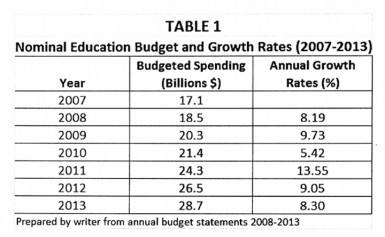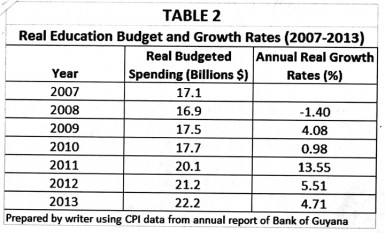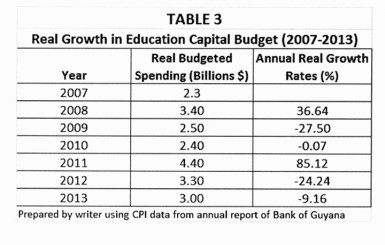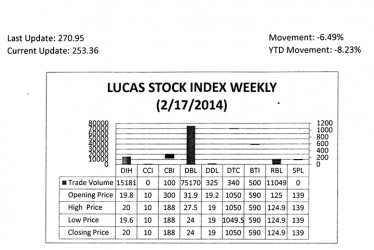Further cuts
Budgeting for education ought to be a simple task for the administration. It is working with a national strategic plan that clearly sets out the goals for education and the strategies to achieve them. The most recent plan expired in 2013 and a new plan is in the works.
Despite the transition, the administration should have a very good idea of what to spend money on in 2014. The budget proposal cannot ignore the reality that several of the goals of the strategic plan of 2008-2013 remain relevant and, in many respects, unfulfilled. Notwithstanding 
Policy focus
The 2009-2013 National Strategic Plan on education had several areas of focus. Many, if not all, of the focus areas appeared at one time or another in the various budget proposals over the past five years. Among the things contained in the plan to improve education in Guyana and to build a functional labour force were strengthening school management and improving the quality of teachers in the classroom. These were seen as essential ingredients in the menu of options for improving the quality of education available to students as were reducing absenteeism, strengthening technical and vocational education and improving skill sets in the sciences, and in information and communication technology. These and other policy lines which seek to make access to education in Guyana universal remain relevant. The demands of the system are many and to report success, one has got to be meeting agreed targets. For the administration, the only target that seems to matter is having 75 per cent of trained teachers in the classroom.
Over the past five years, and based on what it has told the nation, the administration should have placed in excess of 3,000 qualified teachers of various disciplines in schools across Guyana. Teacher training should be reaching many parts of the country and, if the training is as effective as Guyanese are led to believe, the performance of public schools across the nation should be improving.
A full evaluation of this possibility is yet to be made public so no one knows for sure what impact the spending on teacher training and school management are having on student performance. In addition, it should also have in excess of 2,600 teachers capable of teaching information and communication technology in schools.
State of science and technology
One should remain concerned, however, about the state of science and technology in the schools. The strategic plan observed that there is a lack of interest among students in science and technology.
This lack of interest has translated into a lack of interest by prospective teachers in being trained in the subject area at the training college. The effort of past budgets to address this issue is minimal despite the dire circumstances of science and technology and the obvious need for persons skilled in that subject area. Of late the administration has been making noises about science and technology and it is likely that greater attention might be given to the issue in the 2014 budget.
Previous budget proposals in the area of education provide evidence that there could be a nominal expansion of at least 9 per cent in the education budget this year since the administration has been increasing spending in this sector annually. Table 1 below shows the nominal increases in spending that were proposed for the education sector from 2007 to 2013. The smallest increase so far has been in 2010 when the budget grew by a little more than five per cent.
The highest increase to date during the review period is 14 per cent which took place in 2011, an election year. An estimated 14 per cent of the capital investment that was planned was aimed at developing and maintaining the infrastructure used in the education sector. The training of teachers and administrators was an important area of emphasis over the past five years as well.
A national school feeding programme aimed at preventing poverty from denying children a good education was also part of the effort.
The growth in spending was not only in nominal terms. For the most part, it was also true in real terms as could be seen from Table 2 below. Like in the previous discussion in health, the calculation of the proposed real expenditure used 2007 as the base year and it used the Consumer Price Index found in the annual report of the Bank of Guyana for the comparative years. As could be seen from Table 2, the education sector acquired increases in goods and services by an annual average of 5.7 per cent during 2008 to 2013. The largest budgeted acquisition was again in 2011 when the administration planned to increase its acquisition of goods and services by nearly 14 per cent. While the proposed spending was for the most part positive, the rate at which purchases occurred declined. This trend leaves the impression that meeting the education needs of the country in the last few years was troublesome.
This is especially obvious in the area of capital expenditure where the growth in expenditure was positive only in 2011 when it jumped 85 per cent over the prior year. In every other year since 2009, the growth in investment was negative. From this movement in expenditure, it looks as if the growth in capital spending was deliberately timed to coincide with the election year. Irrespective of the motive, the capital investment in education is falling short of expectations.
The primary purpose of education is to meet the needs of the student, and prepare the student to effectively function in the world. The secondary purpose of education is to guide the student to meet the needs of the community. Therefore, effective education is tailored to the needs of the student and to the needs of the community. There is a gap in the education budget where funding hygiene and civic duties falls short. While not the primary purpose of education, it is universally accepted that the school needs to play a role in guiding students in the ways and purposes of community service. From the condition of the yards of public schools and residences, and the behaviour of many road users, especially drivers of motor vehicles, this aspect of education is being neglected. The 2014 budget ought to take that into consideration.
LUCAS STOCK INDEX
The Lucas Stock Index (LSI) declined 6.49 per cent in trading during the third week of February 2014. The stocks of seven companies were traded with a total of 102,665 shares changing hands. There was one Climber and four Tumblers. The shares of Banks DIH (DIH) rose 2.04 per cent on the sale of 15,181 shares while those of Citizens Bank Inc (CBI) fell 37.33 percent on the sale of 100 shares. The share price of Demerara Bank Limited (DBL) fell 24.76 per cent while that of Demerara Distillers Limited (DDL) fell 1.04 percent on the sale of 75,170 and 325 shares respectively. The share price of Republic Bank Limited (RBL) fell 0.08 per cent on the sale of 11,049 shares. The share prices of Demerara Tobacco Company (DTC) and Guyana Bank for Trade and Industry (BTI) remained stable on the sale of 340 and 500 shares respectively.










